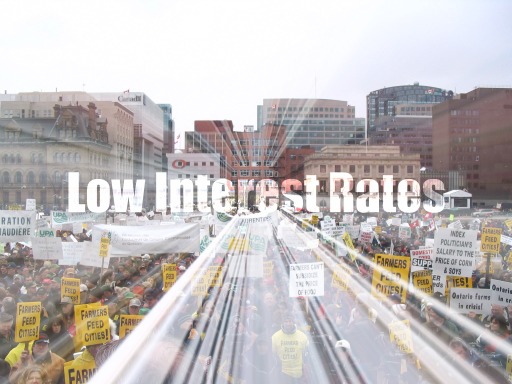 This past winter I had the privilege of having 11 speaking engagements across Ontario and Alberta. I’m usually asked to speak about the markets and this past year has surely been a laboratory for good talking points. Our market volatility has been tremendous and when you add the noncommercial interests and tight fundamentals into the mix, there was a lot of talk about.
This past winter I had the privilege of having 11 speaking engagements across Ontario and Alberta. I’m usually asked to speak about the markets and this past year has surely been a laboratory for good talking points. Our market volatility has been tremendous and when you add the noncommercial interests and tight fundamentals into the mix, there was a lot of talk about.
There was one thing during my presentations I brought up, which I believe is a tremendous stimulus to our agricultural economy. Low interest rates have been a fixture in the Canadian agricultural economy for several years now. This has acted as the “great lubrication” to increase the amount of capital available to Canadian agriculture. Sure, we are a point above our all-time lows with regard to interest rates but with commodity prices where they are, the opportunity to borrow money to invest in agriculture has been incredible. It is a far cry from the day 30 years ago when a southwestern Ontario banker gave me my first demand loan at 23.25%.
So we have in our low interest rate environment a huge stimulus for agricultural growth. However, some would argue that these low interest rates have simply recapitalized themselves back into the price of land, rent and equipment. It is hard to argue that in 2011, especially at a time when savings accounts only render 1% or less. Millions of dollars have been put back into Canadian farmland and the increased value of that land is very telling.
There are a couple things going on here. There is the infusion of capital from the equities markets into farmland and there is simply more money in farm country and that is finding itself being plowed back into the price of land. The one constant is low interest rates. As long as they stay low the agricultural growth machine keeps going.
The question is, when will farmers start to see the last vestiges of the cheap money era? How will this manifest itself in Canadian farm country and will there be the classic gnashing of teeth when it happens? Or, are these times different than anything we have seen in the past and cheap money will continue? The answer of course is blowing in the wind but it also has a lot to do with our friends, US Fed Chairman Ben Bernake and Bank of Canada Gov. Mark Carney see things.
Our American friends have had the worst of times. Their economy has been moribund and the US Federal Reserve has had two rounds of quantitative easing while keeping interest rates at rock-bottom levels. The simple justification of this was to keep prices from decreasing on a consistent basis, while boosting employment and economic activity. Deflation they did not want and a little bit of inflation wouldn’t be so bad. Now with gasoline and food prices rising as well as some other commodities, the US Federal Reserve might be getting what they asked for. Interest rates hikes may be in the offing.
At the same time in Canada Mark Carney has a very difficult problem. The Bank of Canada has raised interest rates but they slammed the brakes on partly in response to the loonie going higher. Our economic growth numbers are good. Regarding inflation, Mark Kearney summed it up this way,” Persistent strength in the Canadian dollar is an important headwind to growth and inflation in Canada.” So he is looking at it as a good thing as the Bank of Canada continues to manage its inflation target of 2%. He also acknowledged that export related industries found the higher loonie very challenging. He suggested that companies need to invest more aggressively in buying new machinery and equipment overseas to help us improve productivity to survive in this high dollar world.
So what does that mean for Canadian agriculture? Are we supposed to spend more and more money to make ourselves more and more productive, which in turn gets capitalized into land and equivalent? Clearly, it is a vicious cycle. You can make an argument that Canadian farmers have got a 40% pay raise since 2002 as the dollar has risen. However, sometimes when you translate that back to the farm level it gets a little muddled. If high interest rates ever come back, that high capitalization is going to be hard to service.
So far in 2011 interest rates remain where they are and even if they are hiked they are still very low. Sure, interest rates hikes are coming. That will keep the loonie high, challenging us again, on the way we do business. It will remain that way until the economic levers that govern the US economy change radically. When that happens, nobody knows. Right now, it seems so far away.